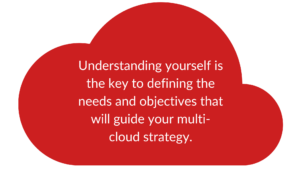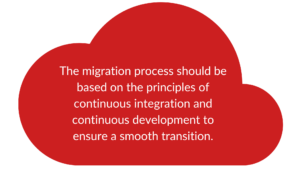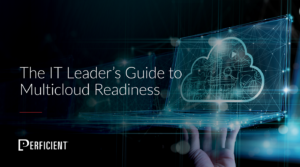As businesses increasingly adopt multicloud architectures to drive innovation and create value, IT leaders face mounting pressure to develop a successful multicloud strategy. While our comprehensive ‘IT Leader’s Guide to Multicloud Readiness‘ provides a detailed exploration of the multicloud migration, this blog post serves as a primer, providing valuable insights into the benefits of a multicloud approach and a step-by-step blueprint to migrating to a multicloud environment. If you have not explored the guide, I highly recommend you do so. It’s free and full of fantastic insights.
By leveraging the information in both resources, IT leaders can make informed decisions to optimize costs, streamline workload deployment and management, ensure critical app and service reliability, and align IT teams and stakeholders for successful multicloud adoption.
Step 1: Define Needs and Objectives for your Multicloud Migration

Whether you’re looking to move from on-prem to the cloud or migrate from one cloud provider to another, it’s important to understand your needs and objectives. Simply wanting to reduce operational costs may not be the only reason, as cloud costs are often determined by the modernization level of your application portfolio. To define your objectives, you need to identify pain points with your current provider and decide what you want to achieve with a multicloud strategy. This could involve a best-of-breed model where you use different providers for different functions.
Additionally, deciding what to move to the cloud, including data, workloads, and identity management, will give you a clearer picture of your migration path. Understanding yourself is the key to defining the needs and objectives that will guide your multicloud strategy.
STEP 2: Understand Different Offerings From the Clouds
To make an informed decision, it’s crucial to understand the different offerings of the clouds. This step involves evaluating various cloud providers based on functionality, performance, and cost. By comparing these features, you can develop an informed cloud adoption strategy to guide your implementation and migration aligned to the business objectives and outcomes most aligned to your organizational goals.
STEP 3: Evaluate Security and Compliance
When considering multicloud adoption, the third step should be to evaluate security and compliance capabilities and requirements. This is crucial because the primary challenge of distributing workloads into multiple clouds is ensuring consistent and comprehensive security, compliance, and governance controls. Your data, workloads, and users are spread across different locations, devices, and platforms, which poses security risks. Make sure you understand all of the security, compliance, audit, and monitoring requirements to ensure your approach is aligned with existing and future organization requirements across your hybrid environment.
[See More Below…]
STEP 4: Cloud Management in your Multicloud Migration
To successfully manage multiple clouds, you need to develop a cloud management strategy to manage all the different environments and resources. This is going to be a challenge as managing multiple clouds can be much more complex than managing a single platform. You need to decide what cloud management tools you are going to use to manage and monitor your assets. You need to decide whose tools you are going to use, whether it is a third-party toolset or the cloud provider’s own native tooling. You also need to understand the cost of each cloud provider and have a cost optimization strategy in place.
As a partner, we can evaluate these tools and provide solutions that are tailored to your needs. We have a solution for each step of the cloud migration process and can advise you based on your needs. Overall, the successful implementation of a cloud management strategy will help you manage your cloud resources efficiently and cost-effectively.
STEP 5: Develop a User Management Strategy
When migrating to the cloud, managing users can become a complex task. In order to avoid managing users separately on different platforms, it is essential to develop a user management strategy. The cloud provides certain tools that connect your corporate directory with the cloud, allowing for a centralized source of truth for user management. This means that all of the clouds pull data from your directory, making it unnecessary to manage users separately on each cloud platform. Additionally, third-party tools such as Okta can be used for user management.
With an effective user management strategy in place, you can ensure a seamless migration to the cloud with minimal disruption to your organization’s operations.
STEP 6: Implementation and Migration to Multicloud
Implementing and migrating to a multicloud environment is a crucial step in the cloud adoption process. In this step, the focus is on moving the data and workloads to the destination cloud.
The first step in implementing and migrating to multicloud is to create a detailed migration plan. This plan should include a timeline, resource allocation, and contingency plans. The migration plan should also outline the data and applications that will be migrated and the order in which they will be moved.
Once the migration plan is in place, the actual migration process can begin. During this phase, data and applications are moved to the destination cloud in a controlled manner. It is important to ensure that there is no loss or corruption of data during the migration process.
To ensure that the migration process is successful, it is important to conduct regular testing and validation of the migrated data and applications. This will help to identify and resolve any issues that may arise during the migration process.
STEP 7: Refine Strategy and Optimize Solution for your Multicloud Migration
Refining the strategy and optimizing the portfolio is an ongoing process. Once the cloud migration is underway, it is important to continuously review the strategy and the solutions to ensure they are meeting the evolving needs of the organization. This can be simplified with continuous integration and development concepts, which allow for the continuous testing and deployment of new solutions and the ongoing optimization of existing solutions based on user feedback and performance metrics. By continuously refining the strategy and optimizing the solution, organizations can ensure that they are making the most of their cloud investment and delivering the best possible outcomes for their business.
Next Steps for Multicloud Migration
A successful multicloud strategy requires careful planning and execution across all seven steps. By following these steps, businesses can develop a strategic approach to multicloud adoption that aligns with their specific business objectives, optimizes costs, and streamlines workload deployment and management. It’s essential for IT leaders to recognize the benefits of multicloud adoption and understand the challenges that come with it, including proper guidance and resources.
For a more in-depth look at multicloud strategy, we highly recommend reading the ‘IT Leader’s Guide to Multicloud Readiness.’ This practical guide provides key insights and important factors to consider in developing a successful multicloud strategy, including identifying the right cloud providers and services for your needs, optimizing costs, maintaining critical app and service reliability, and aligning IT teams and stakeholders for successful multicloud adoption. Download this guide and explore how to make informed decisions in your multicloud strategy to enable innovation and business value.

